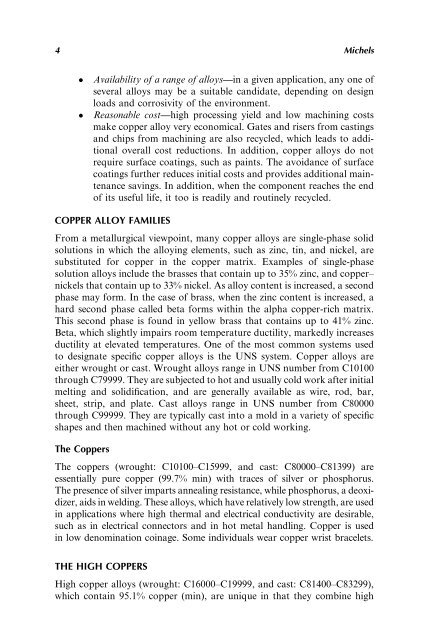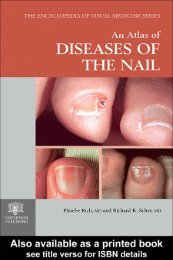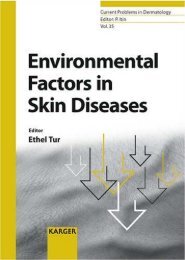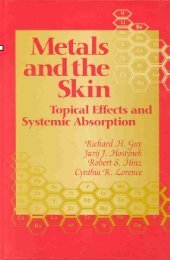- Page 2 and 3: DERMATOLOGY: CLINICAL & BASIC SCIEN
- Page 4: Latex Intolerance: Basic Science, E
- Page 7 and 8: Informa Healthcare USA, Inc. 270 Ma
- Page 10 and 11: Preface Preface Metals have long in
- Page 12: Acknowledgment We gratefully acknow
- Page 15 and 16: x Contents 3. Basics of Metal Skin
- Page 17 and 18: xii Contents 8. Copper in Medicine
- Page 20: Contributors Frank Dreher Neocutis,
- Page 23: 2 Michels good corrosion resistance
- Page 27 and 28: 6 Michels iron, and, in some versio
- Page 29 and 30: 8 Hostynek ELECTRON CONFIGURATION A
- Page 31 and 32: 10 Hostynek stemming from the chemi
- Page 33 and 34: 12 Hostynek Lactate and Pyruvate La
- Page 35 and 36: 14 Hostynek after a lag time of nin
- Page 37 and 38: 16 Hostynek In the living organism,
- Page 39 and 40: 18 Hostynek 24. Sekelj P, Rasmussen
- Page 42 and 43: 3 Basics of Metal Skin Penetration:
- Page 44 and 45: Basics of Metal Skin Penetration: S
- Page 46 and 47: Basics of Metal Skin Penetration: S
- Page 48 and 49: Basics of Metal Skin Penetration: S
- Page 50 and 51: Basics of Metal Skin Penetration: S
- Page 52 and 53: Basics of Metal Skin Penetration: S
- Page 54 and 55: Basics of Metal Skin Penetration: S
- Page 56 and 57: Basics of Metal Skin Penetration: S
- Page 58 and 59: Basics of Metal Skin Penetration: S
- Page 60 and 61: Basics of Metal Skin Penetration: S
- Page 62 and 63: Basics of Metal Skin Penetration: S
- Page 64 and 65: Basics of Metal Skin Penetration: S
- Page 66 and 67: Basics of Metal Skin Penetration: S
- Page 68 and 69: Basics of Metal Skin Penetration: S
- Page 70 and 71: Basics of Metal Skin Penetration: S
- Page 72 and 73: Basics of Metal Skin Penetration: S
- Page 74 and 75:
Basics of Metal Skin Penetration: S
- Page 76 and 77:
Basics of Metal Skin Penetration: S
- Page 78 and 79:
Basics of Metal Skin Penetration: S
- Page 80 and 81:
Basics of Metal Skin Penetration: S
- Page 82 and 83:
Basics of Metal Skin Penetration: S
- Page 84 and 85:
Basics of Metal Skin Penetration: S
- Page 86:
Basics of Metal Skin Penetration: S
- Page 89 and 90:
68 Hosty´nek and Maibach Transform
- Page 91 and 92:
70 Hosty´nek and Maibach levels wa
- Page 93 and 94:
72 Hosty´nek and Maibach Table 4 P
- Page 95 and 96:
74 Hosty´nek and Maibach Table 6 A
- Page 97 and 98:
76 Hosty´nek and Maibach with perm
- Page 99 and 100:
78 Hosty´nek and Maibach Critical
- Page 101 and 102:
80 Hosty´nek and Maibach 17. Pirot
- Page 103 and 104:
82 Hosty´nek et al. Under occlusio
- Page 105 and 106:
84 Hosty´nek et al. Investigated b
- Page 107 and 108:
86 Hosty´nek et al. Figure 1 Plots
- Page 109 and 110:
88 Hosty´nek et al. period copper
- Page 111 and 112:
90 Hosty´nek et al. and the reduct
- Page 113 and 114:
92 Hosty´nek et al. Table 2 Acute
- Page 115 and 116:
94 Hosty´nek et al. sc subcutaneou
- Page 117 and 118:
96 Hosty´nek et al. 38. Yongchao Q
- Page 119 and 120:
98 Hosty´nek and Maibach major ind
- Page 121 and 122:
100 Hosty´nek and Maibach however,
- Page 123 and 124:
102 Hosty´nek and Maibach converts
- Page 125 and 126:
104 Hosty´nek and Maibach Table 1
- Page 127 and 128:
106 Hosty´nek and Maibach The exte
- Page 129 and 130:
108 Hosty´nek and Maibach Table 2
- Page 131 and 132:
110 Hosty´nek and Maibach Identica
- Page 133 and 134:
112 Hosty´nek and Maibach Cu (II)
- Page 135 and 136:
114 Hosty´nek and Maibach 30. Hang
- Page 137 and 138:
116 Hosty´nek and Maibach Reports
- Page 139 and 140:
118 Hosty´nek and Maibach however.
- Page 141 and 142:
120 Hosty´nek and Maibach and hist
- Page 143 and 144:
122 Hosty´nek and Maibach properti
- Page 145 and 146:
124 Hosty´nek and Maibach permeabi
- Page 147 and 148:
126 Hosty´nek and Maibach It shoul
- Page 149 and 150:
128 Hosty´nek and Maibach Table 3
- Page 151 and 152:
130 Hosty´nek and Maibach Table 4
- Page 153 and 154:
132 Hosty´nek and Maibach Table 5
- Page 155 and 156:
134 Hosty´nek and Maibach Benezra
- Page 157 and 158:
136 Hosty´nek and Maibach irritant
- Page 159 and 160:
138 Hosty´nek and Maibach SUMMARY
- Page 161 and 162:
140 Hosty´nek and Maibach Sterry,
- Page 163 and 164:
142 Hosty´nek and Maibach 5. Menn
- Page 165 and 166:
144 Hosty´nek and Maibach 44. van
- Page 167 and 168:
146 Hosty´nek and Maibach 87. Hack
- Page 169 and 170:
148 Hosty´nek and Maibach 126. Mö
- Page 171 and 172:
150 Milanino considered a good reme
- Page 173 and 174:
152 Milanino THE BABYLONIAN-ASSYRIA
- Page 175 and 176:
154 Milanino the Greek culture deve
- Page 177 and 178:
156 Milanino Poppy ‘‘tears’
- Page 179 and 180:
158 Milanino In fact, in 1928 coppe
- Page 181 and 182:
160 Milanino Whitehouse MW, eds. Tr
- Page 183 and 184:
162 Milanino documented intuition b
- Page 185 and 186:
164 Milanino Table 1 Serum Copper C
- Page 187 and 188:
166 Milanino neutrophils) were pres
- Page 189 and 190:
168 Milanino the scavenging activit
- Page 191 and 192:
170 Milanino normal and copper-depl
- Page 193 and 194:
172 Milanino Table 5 Experimental A
- Page 195 and 196:
174 Milanino Table 6 Daily Changes
- Page 197 and 198:
176 Milanino or tissues, in the inf
- Page 199 and 200:
178 Milanino similar to that descri
- Page 201 and 202:
180 Milanino Table 9 Examples of th
- Page 203 and 204:
182 Milanino Another compartment th
- Page 205 and 206:
184 Milanino likely an ‘‘all or
- Page 207 and 208:
186 Milanino affected area, i.e., t
- Page 209 and 210:
188 Milanino their completely sympt
- Page 211 and 212:
190 Milanino and microscopic histol
- Page 213 and 214:
192 Milanino One possibility is to
- Page 215 and 216:
194 Milanino Figure 3 Status of cop
- Page 217 and 218:
196 Milanino The major indices of t
- Page 219 and 220:
198 Milanino taking into account ot
- Page 221 and 222:
200 Milanino within the inflamed si
- Page 223 and 224:
202 Milanino unknown; however the e
- Page 225 and 226:
204 Milanino Table 16 Examples of C
- Page 227 and 228:
206 Milanino effects also by regula
- Page 229 and 230:
208 Milanino Table 17 Some Examples
- Page 231 and 232:
210 Milanino superoxide anions and/
- Page 233 and 234:
212 Milanino The above biological a
- Page 235 and 236:
214 Milanino Table 18 Some Represen
- Page 237 and 238:
216 Milanino Interestingly, a numbe
- Page 239 and 240:
218 Milanino administering a Cu(II)
- Page 241 and 242:
220 Milanino ip intraperitoneal iv
- Page 243 and 244:
222 Milanino 32. Treagan L. Metals
- Page 245 and 246:
224 Milanino 70. Altman PL, Dittmer
- Page 247 and 248:
226 Milanino 106. Crouch RK, Keusle
- Page 249 and 250:
228 Milanino 141. Korolkiewicz Z, H
- Page 251 and 252:
230 Milanino 173. Brewer GJ. Practi
- Page 253 and 254:
232 Milanino 211. Sorenson JRJ. Cop
- Page 255 and 256:
234 Milanino 245. Willingham WM, So
- Page 258 and 259:
10 Copper Jewelry and Arthritis Bre
- Page 260 and 261:
Copper Jewelry and Arthritis 239 Th
- Page 262 and 263:
Copper Jewelry and Arthritis 241 pr
- Page 264 and 265:
Copper Jewelry and Arthritis 243 re
- Page 266 and 267:
Copper Jewelry and Arthritis 245 A
- Page 268 and 269:
Copper Jewelry and Arthritis 247 Th
- Page 270 and 271:
Copper Jewelry and Arthritis 249 su
- Page 272 and 273:
Copper Jewelry and Arthritis 251 ri
- Page 274 and 275:
Copper Jewelry and Arthritis 253 si
- Page 276 and 277:
Copper Jewelry and Arthritis 255 mo
- Page 278 and 279:
Copper Jewelry and Arthritis 257 th
- Page 280 and 281:
Copper Jewelry and Arthritis 259 Fo
- Page 282 and 283:
Copper Jewelry and Arthritis 261 A
- Page 284 and 285:
Copper Jewelry and Arthritis 263 37
- Page 286:
Copper Jewelry and Arthritis 265 77
- Page 289 and 290:
268 Hosty´nek and Milanino of copp
- Page 291 and 292:
270 Hosty´nek and Milanino In vivo
- Page 293 and 294:
272 Hosty´nek and Milanino salicyl
- Page 295 and 296:
274 Hosty´nek and Milanino the sec
- Page 297 and 298:
276 Hosty´nek and Milanino exchang
- Page 299 and 300:
278 Hosty´nek and Milanino PAST US
- Page 301 and 302:
280 Hosty´nek and Milanino salicyl
- Page 303 and 304:
282 Hosty´nek and Milanino experim
- Page 305 and 306:
284 Hosty´nek and Milanino Dependi
- Page 307 and 308:
286 Hosty´nek and Milanino Such pr
- Page 309 and 310:
288 Hosty´nek and Milanino (recomb
- Page 311 and 312:
290 Hosty´nek and Milanino 17. Wal
- Page 313 and 314:
292 Hosty´nek and Milanino 61. Fow
- Page 315 and 316:
294 Hosty´nek and Milanino 99. Cev
- Page 317 and 318:
296 Index [Antiarthritic] copper po
- Page 319 and 320:
298 Index [Copper] development of,
- Page 321 and 322:
300 Index Essential trace element (
- Page 323 and 324:
302 Index Nephrotic syndrome, 273 N
- Page 325 and 326:
304 Index [Skin diffusion] polarity







